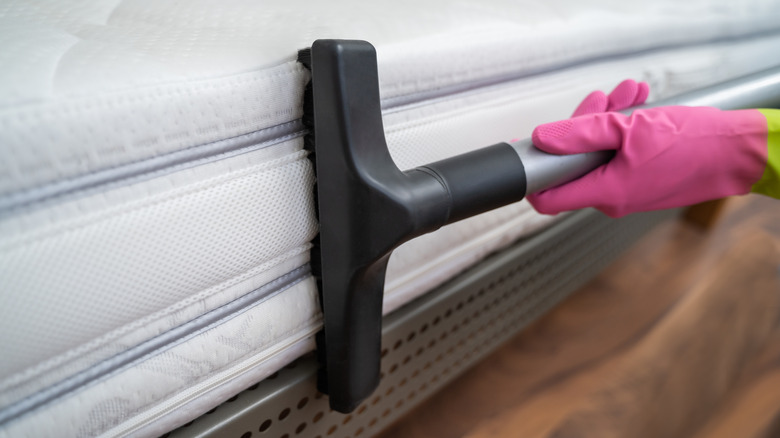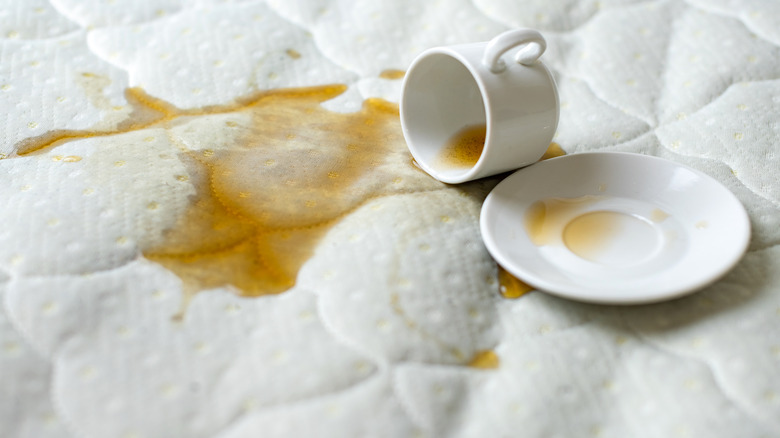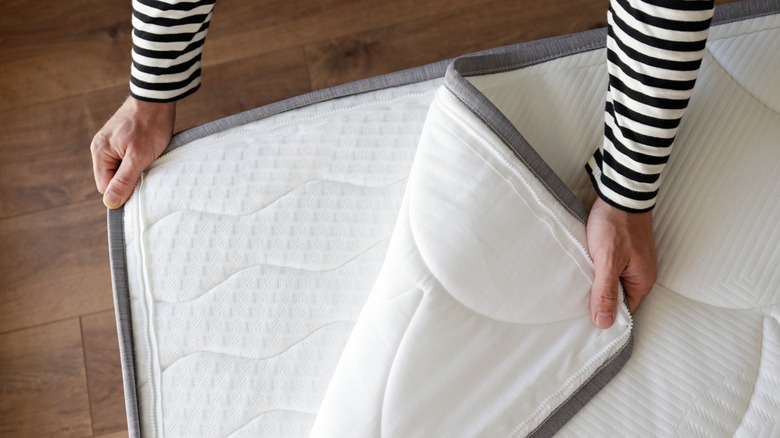How To Dry A Mattress The Right Way
Mattress mishaps are more common than you might think — everything from a spill during a late-night snack, an unforeseen leak in the roof, to an ambitious deep cleaning mattress endeavor, can leave you with a sodden bed. When faced with such scenarios, the task at hand is to adequately dry out the mattress. This might seem like a complicated job given the large size and structure of a mattress. It's not an item that you can simply throw in the dryer or hang on a clothesline. The process of drying a water-soaked mattress involves multiple steps. You start by blotting out as much moisture as you can, then employ a combination of air drying and baking soda to expedite the drying process and freshen up your mattress.
It's essential to remember that the goal isn't just to dry the mattress's surface. You need to ensure that it's thoroughly dried from within. This is of utmost importance to avert any complications that could arise from residual moisture, such as the development of unpleasant smells or even the degradation of the mattress materials. A properly dried mattress is critical to your health and comfort. A wet or damp mattress can serve as an ideal environment for the growth of mold and mildew. These fungi can lead to a range of health problems, including allergies, asthma attacks, and other respiratory issues.
Identifying the source and extent of wetness
Before you start, try to identify the source of the wetness. If it's a small spill, the drying process will be straightforward. But if the wetness is due to a significant spill or flooding, you'll need to assess the extent of the damage, as it might be best for a professional to handle the cleaning process. To dry a fully wet mattress, you'll first need to place a towel on top of the mattress that will absorb as much of the moisture as possible. Apply pressure to the towels to help draw the liquid out.
If you're dealing with a foul-smelling substance such as urine, your next step is to neutralize it using an enzyme cleaner. Follow the instructions on the cleaner bottle to treat the stain. Alternatively, a mixture of vinegar, water, or hydrogen peroxide can prove effective in stain removal. You can also spread a substantial amount of baking soda over the moist spot and let it rest there for several hours, or perhaps the entire night. Baking soda is highly efficient at soaking up moisture and can also aid in getting rid of any leftover odors.
Use your vacuum to suck up all the baking soda and any left-over wetness, then apply rubbing alcohol to a towel and gently wipe the damp area. The final step is to take your mattress outside if it's feasible and the weather permits. Fresh air and sunshine are excellent natural drying agents. However, if taking your mattress outside isn't possible, you can use a hairdryer if needed.
Preventing future mishaps
While knowing how to dry your mattress correctly is crucial, taking steps to prevent it from becoming wet in the first place can save you a lot of hassle. One effective strategy is to use a waterproof mattress protector. This handy tool acts as a shield, blocking any potential damaging moisture from seeping into your mattress. You can prolong the lifespan of your mattress, maintain its quality, and make the overall cleaning process simpler and more manageable.
You might also benefit from placing a dehumidifier in your bedroom. If condensation routinely causes your mattress to become moist, a dehumidifier can help reduce the humidity levels in the surrounding air, creating a less damp environment that's inhospitable for mold and mildew — both notorious for thriving in wet conditions. What's more, a less humid environment encourages quicker evaporation of sweat or any other moisture that may inadvertently dampen your mattress. This means any wetness is less likely to linger, reducing the risk of long-term damage to your mattress.
Finally, let's not forget the bonus benefits of these two methods. The use of a waterproof mattress protector also protects against allergens and dust mites, while a dehumidifier improves air quality by reducing allergen levels. This dual approach ensures a safer and more comfortable sleeping environment, particularly for those with allergies or asthma.


